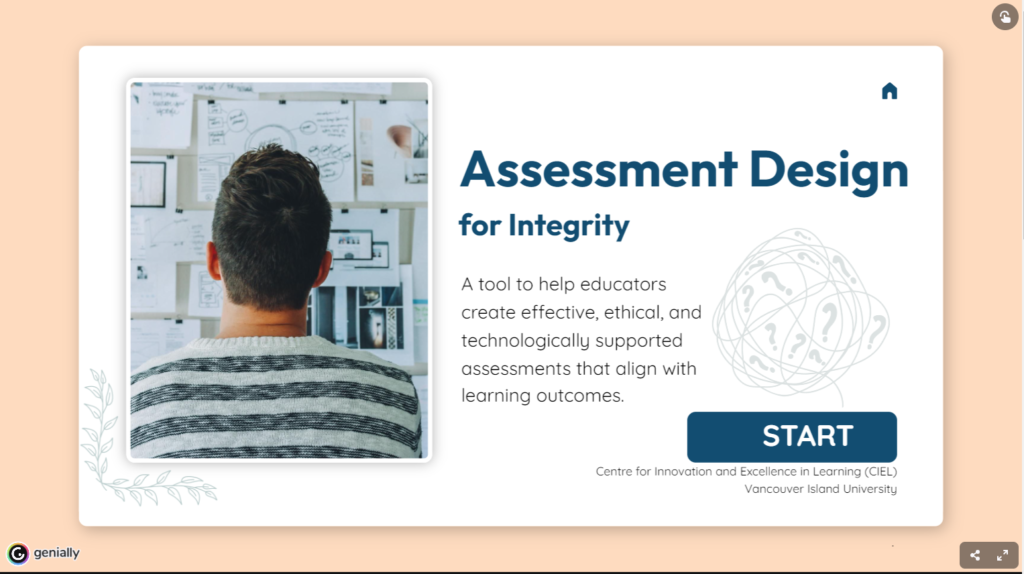Starting a new semester offers a chance to renew existing courses or plan new ones, providing an opportunity to enhance assessments. In this blog, we offer an assessment design decision tool. The tool begins by helping you clarify the purpose of your assessment with learning outcomes. Next, it guides you in creating assessments that support students in making responsible decisions about academic integrity. Lastly, it assists you in choosing and integrating educational technology backed by the SECTIONS model.
The decision tree prompts you to consider assessment design that can mitigate the use of generative AI, while also suggesting ways to incorporate AI for learning and improving critical thinking. The following Assessment Design Decision Tool poses four key questions.
1. Are your learning outcomes effective?
Assessment helps students concentrate on the most critical aspects of a course. The design of assessments is guided by learning outcomes—broad statements that outline what students should know and be able to demonstrate upon completing the course. These outcomes specify the desired end products and the expected depth of learning. They focus on students’ achievements rather than the instructor’s teaching activities. Learning outcomes are crucial for shaping assessment and evaluation methods by clearly defining what students are expected to do, making them a fundamental component of effective assessment planning.
2. Why are you assessing?
Your assessment planning should encompass both formative and summative assessments. From a growth mindset perspective, formative assessment provides frequent opportunities for instructors to give students feedback specific to their learning. At the same time, formative feedback offers instructors feedback on their teaching practices, allowing them to adjust and adapt the learning experience for students based on these findings. Both students and instructors stand to gain from these practices. Collectively, formative assessment and feedback create a culture that aims for continuous improvement on behalf of the student and the instructor.
3. Does the assessment design help students maintain academic integrity?
Academic misconduct has many causes, including misunderstanding of academic policies, pressure to succeed, temptation and opportunity, time management and lack of flexibility, perceived lack of relevance and feelings of stress. Plagiarism or ‘cheating’ often stems from confusion around assessment tasks and expectations. Fostering academic integrity involves carefully selecting relevant and meaningful assessment tasks, being transparent in assessment criteria, and providing unambiguous feedback. Additionally, creating an assessment plan that offers students sufficient time to complete assessments ensures they can engage with the material thoroughly and honestly. Addressing these factors can promote a fair and supportive academic environment.
4. How can your technology choices support assessment and integrity?
When selecting digital media for teaching and assessment, consider how these tools align with your course learning objectives, and choose tools that enhance the educational experience. By systematically evaluating each component of the SECTIONS model, you can achieve a balanced approach that considers both the educational benefits and the ethical implications of technology use in academic environments.
To learn about VIU’s accessible and supported educational technology, see The Centre for Innovation and Excellence in Learning webpage. VIU Information Technology (IT) also provides additional IT-supported software for students and faculty. VIU’s software has been vetted for privacy management as mandated by B.C.’s Freedom of Information and Protection of Privacy Act (FIPPA). FIPPA ensures the protection of personal information for VIU students and employees.
Interact with the content below by answering each question based on your assessment needs and goals. The tool will guide you through various choices to help you design assessments that enhance learning outcomes and uphold integrity. Click anywhere on the image below to start.

References
Bates, A. (2019). Teaching in a Digital Age. Victoria, BC: BCcampus. https://pressbooks.bccampus.ca/teachinginadigitalagev2/chapter/9-1-models-for-media-selection/.
Miles PJ, Campbell M, and Ruxton, G. (2022). Why students cheat and how understanding this can help reduce the frequency of academic misconduct in higher education: A literature review. J Undergrad Neurosci Educ. 2022 Jun 1;20(2):A150-A160. https://www.ncbi.nlm.nih.gov/pmc/articles/PMC10653228/
Teaching and Learning Support Services. (n.d.). Academic integrity. University of Ottawa. https://saea-tlss.uottawa.ca/en/course-design/academic-integrity#misunderstanding-of-academic-policies
To receive an email when we post new content you can subscribe to our blog:
